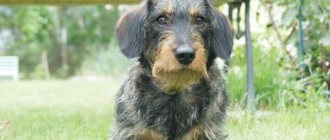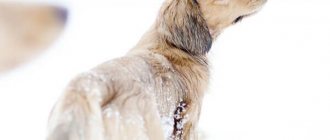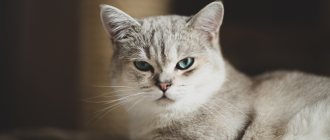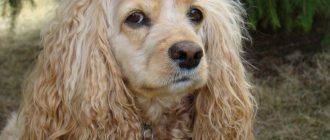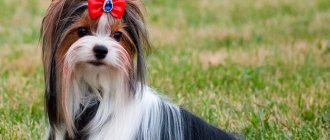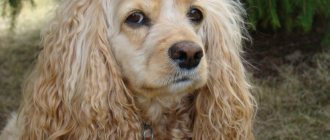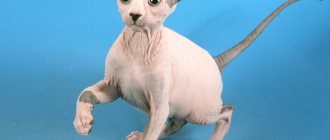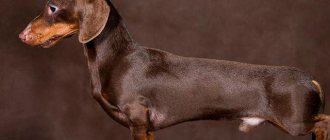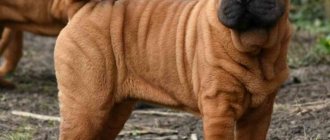When you think about a dog, in addition to its character traits and the goals of the establishment, you undoubtedly think about what the future pet should look like.
The variety of breeds is so great that based on the desired traits, you can choose the ideal potential dog breed that will meet all your needs and dreams. Large and small, pocket and guard, fur-haired and wire-haired dog breeds - canine selection provides a huge selection of many options.
And if you don’t like fluffy clouds on legs, but want something more charismatic and daring, then we present you a list of wire-haired dog breeds from tiny companions to full-sized dogs.
History of the origin of the breed
The Dachshund breed began to develop back in the sixteenth century in Southern Germany. The ancestors of modern taxis are short hounds.
Dachshunds quickly won the love of Europeans. And small game hunters always took a dog of this breed with them. Indeed, thanks to her body structure and hunting talents, she easily climbed into the small narrow holes in which the animal was located.
To improve the breed, breeders began to cross it with other small hunting dogs with hard, dense hair. The goal of the breeders was to increase the hunting aggression of the dachshund and thicken the coat, since hard wool better protects the four-legged dog from cold, humidity and injury. Over time, the body of the taxi drivers became longer and their height shorter.
The Wirehaired Dachshund was recognized in 1915, and at the same time a breed standard was established that is still valid today.
miniature pinscher
Initially, miniature pinschers were bred by German peasants to guard stables and houses, catch rodents and hunt small animals. Dog handlers became interested in small, energetic dogs towards the end of the 19th century. After the release of the first standard in 1880, miniature pinschers spread to cities and became pets. In everyday life they are called dwarf pinschers.
Miniature pinschers are slender dogs with well-developed muscles, 25–30 cm tall. Their ears are set high and point upward or hang down on cartilage. The smooth coat fits tightly to the body and shimmers in the sun. There are 2 colors in the breed: black and tan and solid red-brown. The miniature pinscher's gait resembles that of circus horses. The dogs gracefully raise their forelimbs and gently lower them in front of them.
Active, inquisitive miniature pinschers love to explore the territory, learn new things, and are easy to train. They are friends with school-aged children. They do not have enough gentleness and patience to communicate with children. Miniature pinschers have not lost their instincts as watchmen and guards.
What does it look like
Dimensions and weight of an adult dog
The wire-haired dachshund has three subspecies, which differ from each other in size.
So, a standard dog weighs 7-9 kilograms and has a height at the withers of up to 35 centimeters. Males are larger than females. The rabbit variety is smaller: its weight is 3-5 kilograms and its height is 30-33 centimeters. And the smallest type is a dwarf dog, not exceeding 30 centimeters in height and weighing 2-3 kilograms.
Head, nose, eyes and ears
The head of the gesture is shaped like a wedge with a pointed end. The jaws are developed and powerful, the back of the head also stands out. There is also a hard “beard”, characteristic of the wire-haired breed.
The dachshund's nose has a straight, even back and developed nostrils. Its color is either black or brown, depending on the color of the dog's coat.
Oval eyes are usually bright brown, less often amber or blue.
Dachshund ears are droopy and hang neatly on both sides. Their shape is triangular, they are quite large and rounded at the tip.
Neck and body
The wirehaired breed has a strong neck and a developed scruff. Males have more muscular withers than females.
The dachshund's body itself is large, with an oval protruding chest. The lower back is elongated, the tummy is tucked.
Limbs and tail
The short legs of the gesture are located parallel to each other. The joints of the limbs are developed, the elbows are pressed to the chest. The hind legs are longer than the front legs and are wider apart.
The tail of the gesture is straight, hanging down slightly. A crescent shape is also acceptable. According to the standard, the ponytail should not fall on the back or stand up.
Coat color
The color types of wirehaired taxis are as follows:
- Plain.
- With stains.
- Brindle.
- Two-color.
- Marble.
The colors found in rough-haired dachshunds are black, tan and brown. And small and recently born puppies have a boar color (from a light reddish tint to a dark brown color).
Wire-haired taxis have three main color categories:
- Plain. As a rule, it is red, red or brown. The color on the chest is usually lighter than on the main body.
- Two-color. This is a combination of dark colors - black or brown with red. This is the most common coat color in the breed.
- Blue merle. This is a rare color type that includes brindle and merle. Puppies with such fur are rare, so they are much more expensive than others.
Types of Wirehaired Dachshunds
Dwarf Wirehaired Dachshund
A miniature or dwarf wire-haired dachshund weighs no more than five kilograms, and its height is 30-35 centimeters.
Rabbit wirehaired dachshund
The rabbit subspecies of taxis are the tiniest representatives of the breed. Their height does not exceed thirty centimeters, and their weight is only 2-3 kilograms.
Standard Wirehaired Dachshund
The standard rough-haired dachshund is the most common of the breed. Her height is from 35 centimeters, and her body weight is from 7 to 9 kilograms.
Character and behavior
Gestures are friendly and sociable pets. They get along easily among people and their children. But such pets also have proper self-respect: if he is offended, unreasonably scolded and reprimanded, he will behave accordingly. The pet is able to stand up for itself.
Therefore, if you keep a wire-haired dachshund with a child, you must explain to him that the dog is also a member of the family and you cannot harm it, offend it or beat it. But you shouldn’t leave these two alone; after all, taxis are a hunting breed.
Features of the behavior and character of rough-haired dachshunds include:
- the ability to protect and protect your family;
- these kids will create an atmosphere of fun in the house;
- Taksyata are faithful and devoted comrades. Left alone, they are very worried and miss their owner;
- These are very hardy and physically strong dogs. They are able to run around the apartment all day without a break without getting tired. There is no need to scold your pet for such energy, because this is inherent in its nature. To prevent your baby from throwing out energy at home, you need to take him for walks and play in the fresh air more often;
- Dachshunds are a smart breed with considerable mental abilities;
- Some rough-haired dachshunds are not too fond of other pets in the house. They often perceive small domestic animals as prey;
- Dachshunds are indifferent to strangers. Sometimes, but rarely, they bark at strangers, but the dog will never rush into battle without a reason.
Choosing a pet for a pensioner
With age, people lose their usual mobility and endurance. They begin to value their comfort and are justifiably afraid of the possible hassle of owning a pet. Despite this, many of them sincerely want to see next to them a reliable and devoted companion who will meet a number of criteria.
Dog activity and intelligence
Most retirees do not lead an active lifestyle, so a pet that is too nimble and curious can cause them serious inconvenience. For this reason, working breeds, including hunting dogs, should be avoided.
A more suitable candidate would be phlegmatic four-legged animals that don’t mind skipping a walk in rainy weather and lounging on the sofa with their owner.
IMPORTANT!
Avoid breeds that are prone to dominance and aggression.
Intelligence also plays a significant role, but not so much the direct mind as the obedience of the animal. The easier it is to train, the easier it will be for the owner. Particular attention should be paid to dogs aimed at helping visually impaired people and people with disabilities.
Size
Small size is the most preferred. It is easier to care for such a pet, it easily gets accustomed to the tray, does not take up much space and moves without problems right in the bag.
Large animals are good as protectors, but they are difficult to keep on a leash and bathe in the bathtub. Despite this, keeping a large dog by a pensioner is also acceptable - but only if the four-legged dog is obedient, and its owner has help in the form of children, grandchildren or a hired groomer.
Need for care
Focus on simplicity. Long-haired and fluffy animals shed heavily and require cleaning more often than usual. The ideal choice is smooth-haired or wire-haired breeds that leave virtually no hair behind and do not need to be trimmed.
In addition to shedding and the tendency to tangle the fur, it is important to take into account another important point - the age of the future pet. Puppies take up much more time from their owners, so an adult animal would be preferable.
Maintenance costs
The last point to consider is maintenance costs. Easy to care for, wire-haired dogs do not shed on their own and require trimming. If an elderly person does not have the funds for this procedure, then such a pet will not suit him.
ADVICE!
The annual cost can be calculated by adding up the costs of feeding, vaccinations, basic tests, parasite treatments and essentials. Then you can divide the resulting amount by 12 to get the approximate monthly maintenance cost.
Also, you should not take four-legged animals with poor health. A frequently ill dog will empty not only your wallet, but also your emotional state.
Care and maintenance of the gesture
Feeding
An adult dachshund is fed twice a day. If you give your pet dry food, then you need to buy a product of at least premium class. Even better - super-premium or holistic (environmentally friendly food). The fact is that food from the “economy” segment causes more harm to animals than good.
If you feed your pet natural food, you need to make sure that he receives the required ratio of all nutrients, vitamins and minerals. Authorized products include:
- Lean meat (accounts for more than half of the total diet).
- Kefir, cottage cheese and other fermented milk.
- Vegetables fruits.
- Porridge, cereals.
There is no need to give your wire-haired taxi dog sweets, spicy and smoked foods, as well as flour products. Any food from the usual table is harmful to the dog.
Education and training
Wirehaired dachshunds are extremely active dogs, so their energy needs to be channeled in the right direction. If the gesture immediately senses the authority of the owner, he will be more flexible. Otherwise, the pet will behave wayward and stubborn. Training an adult dachshund is much more difficult.
It is necessary to raise and train a wire-haired dachshund from puppyhood - from two months. Dog trainers recommend teaching your puppy commands such as “Fu” and “No” before the first walk outside. After all, dachshunds are curious animals that do not need a reason to take and eat something from the ground or climb into any hole.
A few important training rules:
- Violent methods must not be used. And also force, scold, and even more so beat your pet. This way you can discourage the baby dachshund from all interest in activities, and he will be afraid of his owner.
- Each correct gesture should be rewarded with a tidbit and verbal praise.
- If the pet is not in the mood to exercise, then you need to postpone training for another day.
Vaccinations and diseases
Taxi drivers are in excellent health. Their life expectancy reaches 12-15 years. Usually, with the right lifestyle, various diseases appear only in old dogs. Diseases characteristic of the breed include:
- Swimmer's syndrome. It develops in puppies that are unable to stand on their feet, or in pets with severe obesity or injuries.
- Heart failure and other heart problems.
- Diseases of the genitourinary system, including urolithiasis.
- Eye pathologies, including cataracts and retinal atrophy.
- Dysplasia of intervertebral discs and joints.
Wirehaired rabbit dachshunds are somewhat weaker in health than the standard species. They often suffer from viral diseases and epilepsy.
To protect your pet from serious infectious diseases (distemper, leptospirosis, enteritis, etc.), it is necessary to vaccinate it in a timely manner. The first vaccination for a tiny dachshund is given at two months of age. Three booster vaccinations will be required up to 12 months of age. As soon as the baby turns one year old, the vaccine is given annually, at the same time.
At one year the dog is vaccinated against rabies.
Mating, pregnancy and childbirth of a dachshund
The wirehaired dachshund is physiologically ready to give birth when it is one year old. There is no need to breed your pet during the first heat cycle; during this period, she is not yet sufficiently formed to bear offspring and give birth. It is optimal to breed a female after her second heat. Males are ready for mating at six to eight months. Mating occurs on the male's territory from one to three times.
Dachshund pregnancy lasts 63 days, that is, a little more than two months. The health of the future offspring directly depends on the care of the pregnant female.
At one time, the wire-haired dachshund gives birth to one to five puppies. Their weight depends on the size of the mother, for example, standard-sized dachshunds usually give birth to fairly large puppies.
Trimming
Coarse-haired dogs require trimming. This procedure involves plucking dead fur using a special device. Trimming is usually carried out in salons, but any owner can learn this at home.
Trimming is carried out at least once every 6 months.
A haircut
Rough-haired dachshunds are allowed to be cut only in the head area, that is, to give shape to the goatee, eyebrows and mustache. Pets with coarse hair are not cut due to the fact that it spoils the structure of the dense coat. It will become soft and weak after cutting.
Coarse-haired taxis have a peculiarity - they go bald at the withers. This is normal and does not require action.
Care for eyes, ears, claws
Lack of care for eyes and ears leads to various diseases. After all, accumulated mucus, wax or plaque is an ideal environment for bacteria to multiply. And long claws interfere with the dog’s movement and disrupt the musculoskeletal structure of the body.
Therefore, the following procedures must be carried out regularly:
- wipe the eyes of the wire-haired taxi dog with a swab dipped in warm boiled water. If there is redness or inflammation of the eyes, you need to wipe them with strong brewed tea;
- To clean your ears, use cotton pads, hydrogen peroxide or a special lotion. Remove wax accumulated in the ears and trim the hair growing in them;
- Nail trimming is another important procedure for your pet. To do this you need to purchase a nail clipper. Only the transparent part of the claw, empty from the inside, needs to be cut off. As a rule, it is 2-3 mm (sometimes less, especially in puppies). If you accidentally hurt your pet, there is no need to panic, you need to treat the wound with hydrogen peroxide and continue cutting further.
Grooming
A rough-haired dachshund cannot be cut. The exception is participation in exhibitions. Instead of a haircut, gestures need trimming. It is carried out in special salons, but you can learn to do it yourself.
Every day the dog should be combed out using a comb with sparse teeth. During molting, brushing of the wire-haired quadruped is carried out even more often: several times a day.
To make it easier to comb dachshunds with coarse hair, silicone products are sold that are applied to the coat before the actual procedure.
Results
In general, if you choose a wire-haired dog breed for yourself and your family, then be prepared that grooming will be very specific. Most of these breeds do not shed in the usual sense of the word; coat changes occur all year round, and dead hairs are combed out with special brushes and plucking procedures are carried out by specialists.
There are breeds whose fur can be managed on your own through regular brushing, but most often, wire-haired dog breeds require a specialist to pluck their hair.
Advantages and disadvantages of the breed
The advantages of the coarse-haired breed are:
- Sociability and friendliness.
- Quick wit and high intelligence.
- Thanks to its hard coat, it does not require particularly careful grooming.
- Cheerful disposition, no tendency to depression or despondency.
- They love children and play calmly with them.
- Adaptability to harsh weather conditions.
The disadvantages of wirehaired taxis include:
- Stubbornness and desire to play pranks. Sometimes it's not easy to calm a dog down.
- The need for frequent and active walks.
- Does not like other small animals in the house.
- He cannot stand loneliness and misses his owner greatly.
Of course, disadvantages are a subjective thing. For some, active and restless dogs are a headache, for others they are a real treat. Therefore, you need to focus on your personal feelings.
Jack Russell Terrier
The founder of the breed is the English clergyman and breeder John Russell. He tried to breed small, fast hunting dogs that are able to pursue prey no worse than hounds and at the same time know how to climb into narrow holes, driving out small game. The breed became famous after the release of the comedy “The Mask” with Jim Carrey. There, the Jack Russell played the role of the curious jumping dog Milo.
The result of D. Russell's selection are hardy, flexible, fast dogs up to 30 cm in height. Ears drooping forward protect the shell from dust and dirt. There are 3 types of coat in the breed: smooth, hard and broken. Color is white with red, black or chestnut markings. Read about terriers up to 30 cm in height in the review of small terrier breeds.
Who is the Wirehaired Dachshund suitable for?
Since Geese are very energetic dogs, they need an equally active owner. He must be prepared for long walks and intense play with the pet. The future owner must be quite patient, because there will be a lot of noise and mischief in his house.
Therefore, people who lead a measured and calm lifestyle and are not ready for its radical change should not start using gestures.
Teddy Roosevelt Terrier
The dogs were originally considered a subgroup of rat terriers. In 1999, the United Kennel Club of the United States recognized it as an independent breed. These are muscular, short dogs with a height of 20–38 cm. The coat is single-layered, semi-hard. The breed was named after the President of the United States, although he did not participate in the breeding of the breed. The politician kept similar dogs and spoke approvingly of them.
Teddy Roosevelt Terriers are obedient, quickly trained dogs with developed instincts of hunter, guard and watchman. They easily adapt to the lifestyle, temperament of the owner and family, but require regular physical activity.
How to choose a rough-haired dachshund puppy?
Rules to help you choose a wire-haired puppy:
- contact only official nurseries with an established reputation;
- you need to study the baby’s pedigree: what his parents and brothers and sisters look like, whether they are sick with anything;
- it is necessary to study the baby’s shelter diet;
- if the puppy does not go into your arms, does not show activity and sits in the corner - perhaps he is sick;
- you need to make sure that the puppy does not have parasites (both skin and intestinal), and that there are no discharges on his eyes and nose;
- you need to try to pick up the baby. If he freezes and tenses, he is scared. It will be more difficult to establish contact with him. If the baby does not sit in his arms and is actively struggling, perhaps he has not yet learned to calm down on his own.
But still, the main selection criterion is the call of the heart of the future owner. Any puppy deserves love and life among people.
Prague rat
This is an old Czech breed, another name is Ratliki. Rat dogs are recognized as the smallest smooth-haired dogs of European origin. The height of ratliks is 21 - 23 cm, weight 2 kg 600 g. Colors - black, brown with rich tan, sand or red. The breed includes dogs with short and semi-long hair.
Rat dogs are lively, tireless dogs without serious flaws. They behave friendly with family members, and wary with strangers. A fragile pet is not left to play with a preschooler unattended. A child may accidentally injure a dog. The breed is recognized by kennel clubs in some countries, including Russia. FCI is still looking closely.
Questions and answers
Who is the Wirehaired Dachshund suitable for?
Active, energetic and quite patient people. For those who prefer a quiet way of life (for example, older people), coarse-haired taxis are not suitable.
What is the character of a wire-haired dachshund?
Wirehaired Dachshunds are highly energetic dogs known for their intelligence, loyalty, and love of people. The hunting instincts of tacks often make themselves felt: on walks they climb into different holes and run away, at home they chase other domestic animals. But a more devoted person cannot be found as a guard and protector.
Pug
Pugs came to Europe from China, where they fell in love with society ladies and became boudoir animals. The first breed club opened in England in 1883. The standard does not specify the height at the withers. The average height of pugs is 30 cm, weight up to 8 kg. The soft, short coat grows evenly without fraying and does not bristle. Colors: cream, black, peach, silver.
By the age of 2–3 years, active, playful pug puppies turn into balanced, charming adult dogs with a stable psyche. They do not offend children, and raising a dog can be safely entrusted to a teenager. Pugs have a good memory, a tendency to imitate, and the ability to train. If there is a lack of socialization, puppies can grow up to be cocky and pugnacious.
Patterdale Terrier
The breed originated in the middle of the 20th century. Residents of the English village of Patterdale bred tireless, gambling, brave dogs to protect livestock from attacks by small predators and hunting in holes. Gradually, dogs spread among farmers and hunters in England. In the 70s they came to the USA, where enthusiasts opened a breed club.
Patterdale Terriers are strong, hardy dogs with a height of 25–38 cm and a weight of 5–9 kg. The coat is short with a thick undercoat. Colors – black solid or with tan, chocolate, red, fawn. Patterdales value hunting passion, tenacious grip, flair, and courage.
Basset Hound
The dogs were originally bred in France for hunting on foot. The animals knew how to persistently follow the trail. They persistently pursued the beast, moving relatively slowly. Then the breed came to Great Britain, where it was improved.
Basset Hounds are massive, short dogs with an elongated body and short, powerful limbs. Thin, long ears hang along the cheeks. If you pull them forward, the tips will reach your nose. The height of the Basset Hound is 33 – 38 cm. The color combines white with black, red or red-brown.
The character of Basset Hounds is calm and gentle. A constantly sad, heavy look creates the false impression of an eternally offended dog. But inside they are quite cheerful, as evidenced by a high-raised or wagging tail.
What kind of hair does a dog have?
Dog breeders and groomers distinguish several types of hair on dogs:
- Middle length. It is formed by long guard hairs and short undercoat hairs. German Shepherds, Labradors, Pugs, Huskies and Huskies have this type of coat.
- Long hair can be with or without undercoat. The first option is typical for spaniels and collies. A striking representative of the breed with long hair without undercoat is the Yorkshire Terrier.
- Smooth. This species is characterized by short guard hair and undercoat. Smooth-haired breeds include: dachshunds, boxers, Dobermans, smooth-haired terriers.
- Tough. This type of coat is characterized by a wire-like guard hair, which makes grooming much more difficult by special clipping or plucking. Schnauzers and Airedales have this type of coat.
- Curly. This type of cover is equipped with undercoat and guard hairs, which are soft. Breeds considered non-shedding: poodles, Bedlington terriers, Portuguese water dog.
Animals of exotic breeds, such as Commander, may also have atypical hair in the form of cords throughout the body, requiring a special professional approach.
Tenterfield Terrier
This is an Australian breed that was developed by crossing miniature fox terriers and aboriginal small dogs. The first breed club opened in 1993. Until that moment, Tenterfields were considered a subgroup of Fox Terriers and were commonly called Mini Foxy. In 2002, the Australian Kennel Council separated the breed. It is currently developing and has not yet been registered with the FCI.
The average height of Tenterfields is 30 cm. The coat is always smooth, the color is white with colored markings of the same tone. By temperament, Tenterfields are typical terriers. These are restless, energetic, gambling dogs with an independent character and a bit of stubbornness.
Boston Terrier
The dogs were bred by American breeders based on English bulldogs and terriers. The head with a short muzzle and massive jaws resembles a bulldog. A toned body, slender limbs - like a terrier. Colors - a combination of black, brown, brindle and white.
The standard divided Bostons into 3 classes based on body weight:
- up to 6.8 kg;
- from 6.8 to 9 kg;
- from 9 to 11.3 kg.
Boston Terriers are versatile family pets. Delicate, obedient dogs build relationships with all households: adults, children of any age, animals. They sensitively capture the mood and do not impose themselves. They are too trusting of strangers, so they make poor watchdogs.
French Bulldog
These are the smallest dogs of the bulldog family. Height at the withers is from 24 cm in females to 35 cm in males, weight 8 – 14 kg. The breed contains dogs with the dwarfism gene. Adult mini bulldogs weigh up to 8 kg and grow up to 28 cm. Breeders consider them a breeding match.
The coat of French Bulldogs is short, soft, without undercoat. Standard colors are solid brindle, fawn or in combination with white. But sometimes non-standard black, blue, and chocolate puppies are born in a litter.
Charming French bulldogs up to 5-6 years old remain active and playful like puppies. With age they behave more restrained. They are not inclined to obey the first request, so they begin to raise a pet in the first days of arrival in the apartment. French bulldogs have many genetic diseases, so it is not advisable to buy them secondhand based on an advertisement. Read more in the description of the French Bulldog breed.
Russian toy
Miniature dogs were bred by Soviet cynologists, trying to create a new decorative breed, similar to English toy terriers. Russian toy dogs turned out to be smaller than their prototype, they have different proportions and head shape. In 2022, the new breed was registered by the FCI. The representatives did not see any signs of a terrier in it and demanded that the name be changed to Russian Toy.
The breed includes 2 groups of dogs: with short and long hair. Smooth-haired cats are covered with a short, soft coat with almost no undercoat. In long-haired hair, the hair grows up to 3–5 cm and is adjacent to the body. The ears and tail are decorated with fringe. Classic colors - black, brown and tan, red. Less commonly found are blue and purple. Height – up to 28 cm, weight up to 3 kg.
The emotional Russian Toy treats his family affectionately and constantly expects reciprocal attention. Due to increased excitability, he reacts sharply to sounds. In a noisy family with loud children, a dog can become stressed. He responds to suspicious noises outside the door with a ringing bark. The puppy will have to be weaned from barking for no reason from early childhood.
